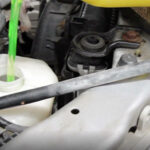Think “vintage” means “outdated?” Think again. Some of the top selling engines on the market today are 20- to 30- year old designs.
The Dodge Hemi was reborn in 2003.
GM’s LS introduced in 1995
The Nissan VQ V6 first appeared in 1994
And the Ford Modular V8 roared to life in 1991.
The list goes on and on.
Yet to call these engines old would be unfair. Thanks to continual innovation and improvements, not only have they endured, they’re better now than before. What is produced by these engines is more fun, more dependable, more efficient and more impressive than when the original models were introduced.
Part of the reason for these improvements has been continual upgrades to what goes INTO the engines. The fluids required to keep these popular engines at the top of the charts have been refined and updated as well. One particular point of progress has been in the oil filter. Even though these engines was cast 20 years ago, filter manufacturers continue to make tweaks to canister shape, filter media, valves and seals.
WHY? Because the materials, R&D and engineering knowledge never stopped evolving. This knowledge allows replacement filter manufacturer to improve their lines to the point where they can exceed the performance of the original filter and even create a better filter for your oil change business.
From the outside, many of the advancements in filter design may not be obvious, but over the past two decades, advances in pleated media and motor oil have given OE vehicle manufacturers the ability to downsize from 3-5/8˝ filters to 3˝ filters on the same size engines. They still have the same threads configuration – these smaller filters sacrifice nothing in terms of strength, performance.
In fact, today’s filters have higher hydrostatic burst strength. They have greater impulse fatigue strength, so they’re more durable. They’re easier to install and they give more coverage with fewer SKUs. Many of the filters have advanced gasket materials designed to be compatible with full-synthetic oils.
Oil pressure is not affected by filter volume and, in fact, today’s more compact filters trap more dirt and retain less oil so they’re both more efficient and more environmentally friendly.
The fact is, there hasn’t been a new automobile or light truck engine designed with a 3 5/8” filter for more than 10 years. Most of the high horsepower engines produced today use the smallest filters.
For engines with longevity, popularity and multiple platforms, there might have been multiple filter specifications. But as we’ve seen, filter mounting plate and diameter have largely stayed the same. Filter manufacturers have stayed on top of these changes. They can consolidate a part number while improving performance of the oil filtration system. It is a win-win.
This video is sponsored by Auto Value and Bumper to Bumper.

